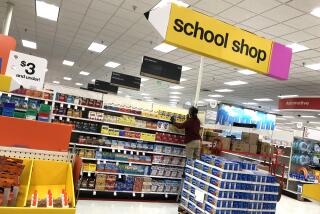The Math on School Shopping
- Share via
Shoppers are loading up this year on perennial back-to-school favorites such as jeans, shirts and sneakers, with parents planning to spend an average of 12% more for clothing and other supplies.
“It’s sort of funny because it really hasn’t changed a lot from years ago, with jeans, shirts and pants and things like that being the basics of what people are looking for,” said Andrea Kent, director of the Retail Marketing Group for American Express Travel Related Services Inc.
Overall, back-to-school spending is projected to rise 12% to an average of $363 per child, American Express said in its second annual survey of 1,000 shoppers.
What’s behind the trend, American Express said, is an emphasis on brand-name goods; lower retailer inventories, which reduce the amount of discounted merchandise; and greater consumer confidence.
According to the survey, 18% of parents said they planned to spend $500 or more per child on back-to-school items such as clothing, supplies, books and electronics.
Across the board, clothing accounts for the highest portion of the back-to-school budget. The percentage is highest for elementary pupils, at 66% of the budget, and for high school students, at 63%. Among college students, clothing accounts for 33% of the budget, followed by textbooks at 25%.
“College students have a much greater demand for other items. . . . Textbooks are a very high expense for college students, accounting for 25% of their back-to-school budget,” Kent said.
Curiously, the American Express survey found that college boys are dramatically more style-conscious than college girls, a finding that is contrary to what last year’s survey found.
The back-to-school season is the second-largest selling season for retailers, and department stores are getting a large portion of the sales. The season has taken on even more importance this year because the time between Thanksgiving and Christmas, retailers’ No. 1 selling season, is five days shorter this year.
“The department stores are back with a bang. They are fighting for the purse, hearts and minds of the mall brats, and they are flexing their fashion muscles,” said Alan Millstein, president of Fashion Network Inc., a New York-based retail consultant.
The American Express survey shows that discount department stores are capturing 35% of sales, followed by malls at 29% and department stores at 26%. Other retailers, such as factory outlets and office supply stores, accounted for 10%.
The decision of where to shop is mostly made by parents, the survey found, although children had more influence over what to buy.
“If you let your kids pick out what . . . to buy, they are more likely to want to wear it,” Kent said. “Back when I was a kid, my mom took me shopping and she picked out what she liked for me.”
What kids are picking out are jeans, with the Levi’s brand being the most popular, Kent said. Jeans are also an important draw for department stores trying to lure high school and college students. Jeans offerings include those from designers such as Tommy Hilfiger, Ralph Lauren and Calvin Klein.
Millstein added that low-slung, hip-hugging jeans with wider bottoms have become big sellers.
“Anything that has a . . . retro look of the peace march is back in fashion and selling,” Millstein said.
Among the hot-selling items at Target, the discount department store chain owned by Dayton Hudson, are T-shirts and accessories such as clay rings and necklaces that are reminiscent of the 1970s, according to Dayton Hudson spokeswoman Susan Eich.
Other popular items include jumpers for girls, backpacks, clogs and “anything with zippers,” she said.
More to Read
Inside the business of entertainment
The Wide Shot brings you news, analysis and insights on everything from streaming wars to production — and what it all means for the future.
You may occasionally receive promotional content from the Los Angeles Times.










